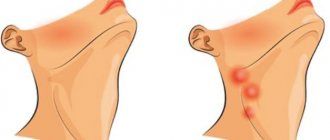Inflammation of the lymph nodes Swollen lymph nodes, or scientifically, lymphadenitis, is a condition in which the lymph nodes enlarge, become dense and can hurt and accumulate pus.
There are many lymph nodes in the body: they are located in clusters along large veins. And any of them can become inflamed, sometimes for harmless reasons that do not require treatment. Unfortunately, the latter does not apply to the inguinal nodes. Their inflammation is a sure sign of problems.
Lymphatic system. Author: Alila Medical Media / Shutterstock
Why does it hurt in the groin in women?
Skin pathologies
Women who remove hair from their bikini area are more likely to develop localized infections in the hair follicle area.
Folliculitis is characterized by redness and the formation of a lump, followed by the formation of a conical pustule filled with pus. The pain is raw, aggravated by pressure and friction of linen. The general condition is not disturbed. The abscess opens spontaneously and heals within about a week. The rashes are often multiple in nature, spreading from the inguinal folds to the pubis and the anterior inner surface of the thighs. If hygiene rules are not followed or the immune system is weakened, complications in the form of boils, carbuncles and abscesses are possible. The progression of the infection is indicated by increased pain, twitching, throbbing pain that deprives you of sleep at night, increased body temperature, and deterioration of the general condition.
Hernias
Inguinal hernias are diagnosed less frequently in women than in men. Characterized by dull, constant or periodic pulling and aching painful sensations in the groin. Irradiation to the lumbosacral region is possible. If the bladder gets into the hernial protrusion, pain above the pubis and dysuric disorders are observed, if the cecum is flatulence, constipation. After operations, the formation of a recurrent inguinal hernia is possible, accompanied by the same symptoms as a regular hernial protrusion.
When a hernia is strangulated, there is a sharp increase in pain against the background of physical effort and abdominal tension. The painful sensations are acute, extremely intense, and are accompanied by the development of painful shock with increased heart rate, a drop in blood pressure and paleness of the skin. A decrease in pain intensity over several hours does not indicate normalization of the condition, but the development of necrotic changes and damage to nerve endings.
In addition, pain in the groin in women accompanies a femoral hernia. In the early stages, the pathology is asymptomatic or manifests itself as discomfort and slight pain during active movements. Subsequently, a protrusion appears in the inguinal-femoral fold, increasing with straining and vertical position of the body. The pain remains dull, aching, nagging, but its intensity increases somewhat. As in the previous case, when the intestines are involved, defecation disorders are observed, and when the bladder is affected, dysuria develops.
Lymphadenopathy due to STIs
Enlarged and painful inguinal lymph nodes in combination with itching of the genitals, pain during urination, and the appearance of pathological discharge from the genital tract may indicate the development of an STI. Lymph nodes are mobile elastic formations that are painful when touched. Local hyperemia and hyperthermia are possible. Inguinal lymphadenopathy in women is observed with the following genital infections:
- Genital herpes.
Malaise and general hyperthermia are noted. Along with the enlargement of the lymph nodes, the appearance of transparent small bubbles in the perineal area is characteristic. Elements of the rash spontaneously open, forming superficial erosions. - Gonorrhea.
Lymphadenopathy is bilateral, the nodes are slightly painful on palpation, the skin over them is slightly hyperemic. Purulent leucorrhoea with an unpleasant odor, itching and mild pain in the external genitalia, nagging pain in the lower abdomen, and dysuric disorders are detected. - Primary syphilis.
The lymph node is enlarged on one side, there is no significant pain, a feeling of discomfort prevails. Lymphadenopathy is preceded by the appearance of a painless ulcer (chancre) on the perineum or labia. When located in the vagina or on the cervix, chancre formation goes unnoticed.
In addition, minor pain in the groin caused by damage to regional nodes due to STIs can bother patients with chlamydia, mycoplasmosis and ureaplasmosis. However, in women this symptom appears less frequently than in men, due to a more pronounced tendency to a primarily chronic, asymptomatic course of the listed pathologies.
Groin pain in women
Other lymphadenopathy
The cause of nonspecific lymphadenitis with nagging, aching and bursting pain in the groin can be purulent wounds and local infectious processes (carbuncle, furuncle, cellulitis, abscess) of the lower limb. In case of varicose veins, this symptom may be due to the development of thrombophlebitis; in diabetes mellitus, it is associated with the formation of trophic ulcers. The lesion is characteristically unilateral. In acute conditions, intoxication is observed; painful red stripes may be found on the thigh - a sign of lymphangitis.
When the inflamed node suppurates, caused by hypothermia, decreased immunity against the background of concomitant diseases, a dangerous complication develops - adenophlegmon. Characterized by increasing, pulsating, bursting sharp pains that make movement difficult and deprive you of sleep. Weakness, hyperthermia, general intoxication, increased swelling and hyperemia on the affected side of the groin are noted. The contours of the lymph node become unclear, and after a while an area of fluctuation forms.
Painless or painless woody lymph nodes in the groin are also detected during metastasis of malignant tumors of the perineal skin (including vulvar melanoma). They are detected with cancer of the anus, neoplasms of the uterus, vagina and fallopian tubes.
Gynecological diseases
Pain in the groin in gynecological pathologies is caused by the close location of the genital organs, frequent irradiation to the groin area, and the development of lymphadenopathy. Caused by the following diseases:
- Vulvitis.
Enlarged lymph nodes occur even before other symptoms appear, but often go unnoticed due to the absence of pain. Then there is pain, burning and itching in the perineum, swelling and redness of the labia, pain when urinating. Pain from the affected area sometimes spreads to the inguinal folds. - Bartholinitis.
With non-purulent inflammation, lymphadenopathy, as in the previous case, is often asymptomatic. With the development of purulent bartholinitis and the formation of an abscess of the Bartholin gland, the node on the affected side increases significantly in size. Intoxication, hyperthermia, a combination of sharp, throbbing, jerking pain in the perineum with dull aching pain in the groin are observed. - Vaginitis.
Enlarged, slightly painful lymph nodes are detected on both sides. Dysuria, moderate nagging or aching pain in the lower abdomen, radiating to the groin, and pathological discharge from the vagina are noted. Body temperature is elevated to low-grade levels.
The symptom is also found in a number of other gynecological diseases. Pain in the lower abdomen radiating to the groin is accompanied by:
- adhesive disease after surgical interventions and inflammatory processes in the pelvis;
- emergency conditions: parametritis, pelvioperitonitis, ectopic pregnancy;
- lesions of the uterus and surrounding tissue: endometritis, large uterine fibroids;
- cervical pathologies: cervicitis, stenosis of the cervical canal;
- diseases of the ovaries and fallopian tubes: adnexitis, salpingitis, salpingoophoritis, ovarian cyst;
- other diseases: endometriosis, genital prolapse, algodismenorrhea.
Pathologies of the urinary organs
In women with urolithiasis, sudden, extremely intense pain in the groin is provoked by a low-lying stone. Combined with lower back pain. Weakness, pallor, frequent urge to urinate or urinary retention, and blood in the urine are noted. Other urinary system disorders that cause groin pain include:
- urethritis, urethral cancer;
- cystitis in women, detrusor injuries, bladder cancer;
- hydroureter, ureteritis;
- hydronephrosis, kidney adenocarcinoma.
Chronic pelvic pain syndrome
It manifests itself as a dull, aching painful sensation in the groin, lower abdomen, pubic area, perineum, sacrococcygeal region. CPPS in women is characterized by persistent pain, lack of clear localization, and a tendency for discomfort to migrate. The symptom lasts for 6 months or more. It intensifies against the background of hypothermia, defecation, urination, stress, exertion, and prolonged stay in a stationary position.
Gastrointestinal diseases
Pain in the right iliac and inguinal region is observed with a low location of the appendix. Acute appendicitis is characterized by cutting, burning, stabbing, jerking, dull or sharp pains, which are combined with diarrhea, nausea, vomiting, and general hyperthermia. In chronic appendicitis, the painful sensations are aching, dull, persist constantly, or occur during movements and diet disorders.
Pain in the groin on the left, complemented by pain in the abdomen and left iliac region, sometimes accompanies the following pathologies:
- sigmoiditis;
- irritable bowel syndrome;
- chronic constipation;
- sigmoid colon cancer;
- intestinal obstruction.
Lesions of the musculoskeletal system
Pain in the groin in women accompanies ARS syndrome. Pathology is diagnosed in female athletes. There is unilateral pain radiating to the leg and lower abdomen. The symptom intensifies with exertion, palpation of the damaged area, hip abduction, and muscle tension. In addition, irradiation to the groin is detected when:
- sprain of the hip joint;
- femoral neck fracture;
- coxarthrosis.
Medical examination
Nonspecific infections
The groin area is far from sterile.
Therefore, inflammation of the lymph nodes in this area can be caused by “ordinary” pyogenic flora.
Inguinal lymphadenitis accompanies:
- Purulent skin infections (streptoderma and pyoderma) of the groin.
- Boils of the pubis, perineum.
- Carbuncles.
- Ingrown hair.
We must not forget about nonspecific genital infections.
Pyogenic flora in women leads to inflammation of the glands of the vestibule of the vagina (bartholinitis), in men it causes infectious lesions of the foreskin and coronary sulcus.
For nonspecific infections, it is almost always characteristic that symptoms of inflammation of the inguinal lymph nodes appear after or simultaneously with the development of an acute process - a wound, ulcer, abscess.
Diagnostics
Women, as a rule, turn to a gynecologist. If necessary, a dermatologist, urologist, and surgeon take part in the examination. During the conversation, the circumstances under which the symptom first arose are established, the dynamics of its development, and its connection with various factors are examined. As part of a general examination, local purulent foci and signs of damage to the gastrointestinal tract, urinary tract and musculoskeletal system are identified.
For folliculitis, dermatoscopy is performed. In patients with local infectious processes, purulent discharge is collected. To clarify the diagnosis, the following procedures are prescribed:
- Gynecological examination.
It is carried out to identify inflammatory and non-inflammatory diseases, tumors of the genital organs. The condition of the vulva, vagina, uterus and appendages is examined, signs of emergency conditions are determined, discharge is taken, and sometimes tissue samples are taken for morphological examination. - Ultrasonography.
Ultrasound of the pelvic organs is informative for gynecological pathologies and CPPS. Ultrasound of the abdominal organs is prescribed for damage to the gastrointestinal tract. For patients with suspected urolithiasis and other urinary tract diseases, ultrasound of the kidneys and ureters and ultrasound of the bladder are recommended. - Radiography.
To examine the condition of the uterus and appendages, hysterosalpingoscopy is performed. Women with diseases of the kidneys, ureters and bladder are referred for excretory urography or cystography. For some diseases of the digestive system, irrigoscopy is performed. Patients with injuries and orthopedic diseases are prescribed x-rays of the hip joint. - Endoscopic studies.
Taking into account the presumed localization of pathological changes that provoke pain, women can undergo hysteroscopy, cystoscopy, urethroscopy and colonoscopy. If acute appendicitis is suspected and other diagnostic procedures are insufficiently informative, laparoscopy is performed. - Lab tests.
The list may include general blood and urine tests; PCR tests to exclude STIs; microscopy of urogenital smear; bacterioscopy of discharge from the genital tract and purulent discharge from skin lesions; cytological examination of smears to identify atypical cells; histological analysis of a biopsy of the lymph node, genitals, anus or urinary tract; stool occult blood test.
Structure of the groin area
The groin area includes:
- Pelvis – it contains the internal organs of the genitourinary system. The pelvis consists of two pelvic bones, the coccyx and the sacrum. During childbirth, the pelvis plays the role of a channel that carries the fetus out.
- The bladder is part of the genitourinary system; its main function is to store urine and remove it through the urethra.
- The urethra is an organ that is a tube. In women, the tube has a length of three to five centimeters and performs the only function of removing urine from the body. The short length and width of the urethra facilitate the entry of pathogenic microorganisms into the body that cause inflammation.
- The rectum is the last organ of the digestive tract. The main functions of the rectum are the formation and accumulation of feces.
- The ovaries are paired glands of the female reproductive system; follicles develop in them, an egg is formed, and hormones are produced. A dominant follicle is formed in the ovary every month, and an egg develops inside it. When the follicle bursts, an egg is released: the process of ovulation occurs. Subsequently, the egg passes through the fallopian tube into the uterine cavity. If conception does not occur, the woman begins her period.
- The fallopian tubes are a paired organ consisting of tubes, the main function of which is to release the egg into the uterine cavity.
- The uterus is a muscular organ of the female body. The uterus is the receptacle for the fetus and brings it out during childbirth. One of the functions is menstrual, provoking the excretion of the mucous membrane of this organ.
- The vagina is a muscular fibrous tube reaching a length of six to ten centimeters. The vagina performs a protective function, keeping the reproductive organs safe. Vaginal discharge is considered normal, as it is necessary to moisturize the mucous membrane and prevent drying. Healthy discharge is white, transparent, mucous and does not have a bad odor.
In addition to the above organs in the groin area, the uterine ligaments, nerves and lymph nodes are susceptible to inflammation.
Treatment
Conservative therapy
The therapeutic plan is drawn up taking into account the cause of groin pain. Women can be prescribed:
- Painkillers.
To eliminate pain, analgesics and NSAIDs are used. Medicines may be used strictly as prescribed by a specialist after diagnosis. Failure to follow recommendations can smooth out the symptoms of pathology and make it difficult to identify dangerous conditions. - Antibacterial agents.
For nonspecific infectious processes, broad-spectrum drugs are used; after receiving the culture results, the antibiotic is replaced, taking into account the sensitivity of the microorganisms. For specific infections, drugs are selected that have the most powerful effect on a particular pathogen. - Other medicines.
Depending on the nature of the pathology, treatment can be carried out using diuretics, antispasmodics, etc. In some cases, women are prescribed hormonal therapy. For pain in the groin caused by orthopedic diseases, therapeutic blockades are performed. - Physiotherapy.
UHF, electrophoresis, ultrasound, laser therapy, and magnetic therapy can be effective. When joints and ligaments are affected, the regimen includes massage and physical therapy.
Radiation therapy or chemotherapy is indicated for patients with cancer pathologies. For local purulent processes, dressings are performed.
Surgery
Women with pain in the groin area undergo the following operations:
- Local infections, lymphadenitis:
opening, drainage of boils, abscesses; opening of purulent lymphadenitis and adenophlegmon. - Hernias:
laparotomic and laparoscopic hernioplasty for inguinal and femoral hernias using own tissue or mesh grafts. - Gynecological pathologies:
opening of an abscess and removal of the Bartholin gland, excision of foci of endometriosis, laparoscopic tubotomy or tubectomy for ectopic pregnancy, removal of cysts, fibroids and benign tumors, amputation of the uterus, hysterectomy or panhysterectomy for malignant neoplasia. - Urological diseases:
various options for lithotripsy for stones, ureterolithotomy, pyelolithotomy, ureteral stenting, partial and radical nephrectomy, TUR of the bladder, cystectomy. - Gastrointestinal diseases:
open or laparoscopic appendectomy, elimination of intestinal obstruction, dissection of adhesions or bowel resection for intestinal obstruction. - Orthopedic pathologies and injuries:
operations for ARS syndrome, endoprosthetics, open osteosynthesis of the femoral neck.










